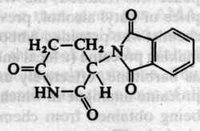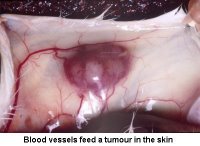thalidomide
Thalidomide is a name that could scare the bejusus out of me--and many other kids as well as adults back then. I was born in 1961--the year that Thalidomide was linked to thousands of birth defects in Europe. Now, after a long absence, thalidomide is being sold by Celgene.
I remember as a small child seeing news reports on how the Thalidomide Babies were doing as they grew up. Seeing images of kids the same age as me with horrible birth defects was scary. I can't imagine how horrid those images would be for the parents of that time period.
 We didn't have many cases in this country due to the FDA stepping in and exerting authority at a time when that was not its usual role. Had it not been for Thalidomide, the FDA probably wouldn't have nearly the power it does have now. History is full of these little moments when the future is altered by one event.
We didn't have many cases in this country due to the FDA stepping in and exerting authority at a time when that was not its usual role. Had it not been for Thalidomide, the FDA probably wouldn't have nearly the power it does have now. History is full of these little moments when the future is altered by one event.
Here's the definition of Thalidomide Baby from MedicineNet:
The reason I bring this history up is that Thalidomide is being used--successfully--in several cancer treatments today. Testing in patients began in 1997--a small 84 patient study--and a year later a version was released commercially though it was for treating leprosy. In 2005 a new version of thalidomide was released under the name of Revlimid for treating multiple myeloma and 5q syndrome.
 My boss had a close view of this process though she wasn't directly involved. She worked for three years in the lab of Judah Folkman, who along with Robert D'Amato (both of Harvard University) did research on how thalidomide works to prevent blood vessel growth, AKA angiogenesis. That's the research question I work on--just what genes affect angiogenesis.
My boss had a close view of this process though she wasn't directly involved. She worked for three years in the lab of Judah Folkman, who along with Robert D'Amato (both of Harvard University) did research on how thalidomide works to prevent blood vessel growth, AKA angiogenesis. That's the research question I work on--just what genes affect angiogenesis.
To the left there is a picture of the increase in angiogenesis caused by a cancer tumor in the skin. Tumors like this force more blood vessels to be created by the body so as to allow the tumor to grow. Much of the current research in preventing tumor growth is based on stopping this process.
I remember as a small child seeing news reports on how the Thalidomide Babies were doing as they grew up. Seeing images of kids the same age as me with horrible birth defects was scary. I can't imagine how horrid those images would be for the parents of that time period.
 We didn't have many cases in this country due to the FDA stepping in and exerting authority at a time when that was not its usual role. Had it not been for Thalidomide, the FDA probably wouldn't have nearly the power it does have now. History is full of these little moments when the future is altered by one event.
We didn't have many cases in this country due to the FDA stepping in and exerting authority at a time when that was not its usual role. Had it not been for Thalidomide, the FDA probably wouldn't have nearly the power it does have now. History is full of these little moments when the future is altered by one event.Here's the definition of Thalidomide Baby from MedicineNet:
Thalidomide baby: An infant affected by prenatal exposure to the drug thalidomide. This medication was prescribed to pregnant women for treatment of morning sickness until removal from the market in 1962. It causes a wide variety of serious birth defects, including short, flipper-like limbs. Most thalidomide babies have lived into adulthood. This population is now reaching middle age, and in some cases new health problems are emerging.
The reason I bring this history up is that Thalidomide is being used--successfully--in several cancer treatments today. Testing in patients began in 1997--a small 84 patient study--and a year later a version was released commercially though it was for treating leprosy. In 2005 a new version of thalidomide was released under the name of Revlimid for treating multiple myeloma and 5q syndrome.
 My boss had a close view of this process though she wasn't directly involved. She worked for three years in the lab of Judah Folkman, who along with Robert D'Amato (both of Harvard University) did research on how thalidomide works to prevent blood vessel growth, AKA angiogenesis. That's the research question I work on--just what genes affect angiogenesis.
My boss had a close view of this process though she wasn't directly involved. She worked for three years in the lab of Judah Folkman, who along with Robert D'Amato (both of Harvard University) did research on how thalidomide works to prevent blood vessel growth, AKA angiogenesis. That's the research question I work on--just what genes affect angiogenesis.To the left there is a picture of the increase in angiogenesis caused by a cancer tumor in the skin. Tumors like this force more blood vessels to be created by the body so as to allow the tumor to grow. Much of the current research in preventing tumor growth is based on stopping this process.

Comments
Thanks for the food for thought.
sorry, but with that last pic, that's all I can think of to say. Not very intellectual is it?
Lois Lane
Lora, that's actually pretty typical of drugs that are small molecules. Thalidimide has a folicular weight of 258 so it's quite small for a bioactive molecule. For comparison, 2-methoxyestradiol, a breakdown product of estrogen, is 302. That's one of the drugs I work with and steroids in general are quite small--which is one of the reasons they have so many profound affects on the mind and body.
Michelle, my mother mentioned that sort of thing to me also since she was able to get Thalidomide up in Canada, only 60 miles from where I grew up.